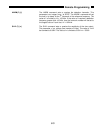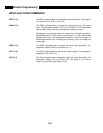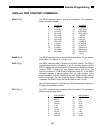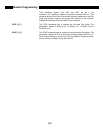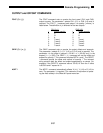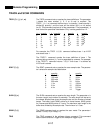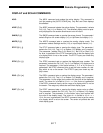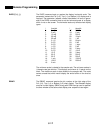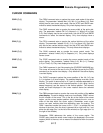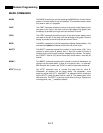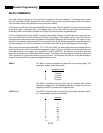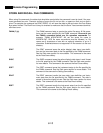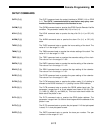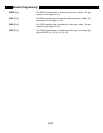
6-13
Remote Programming
CURSOR COMMANDS
CSEK (?) {i} The CSEK command sets or queries the cursor seek mode of the active
display. The parameter i selects Max (i=0), Min (i=1) or Mean (i=2). Each
display has its own cursor seek mode. Use the ATRC and SMOD com-
mands to select the desired display. Only chart displays have a cursor.
CWID (?) {i} The CWID command sets or queries the cursor width of the active dis-
play. The parameter i selects Off (i=0), Narrow (i=1), Wide (i=2) or Spot
(i=3). Each display has its own cursor width. Use the ATRC and SMOD
commands to select the desired display. Only chart displays have a
cursor.
CDIV (?) {i} The CDIV command sets or queries the vertical divisions of the active
display. The parameter i selects 8 (i=0), 10 (i=1) or None (i=2). Each dis-
play has its own vertical division mode. Use the ATRC and SMOD com-
mands to select the desired display. This only affects chart displays.
CLNK (?) {i} The CLNK command sets or queries the cursor control mode. The
parameter i selects Linked (i=0) or Separate (i=1). Only chart displays
have a cursor.
CDSP (?) {i} The CDSP command sets or queries the cursor readout mode of the
active display. The parameter i selects Delay (i=0), Bin (i=1), Fsweep
(i=2) or Time (i=3). Only chart displays have a cursor.
CMAX The CMAX command is just like pressing the [CURSOR MAX/MIN] key.
The cursor will move to the max or min of the data (as set by the CSEK
command) on the active chart display . Only effective if the active display
is a chart display.
CURS? i The CURS? command queries the cursor position of the full (i=0), top
(i=1) or bottom (i=2) chart display. The selected display must be a chart
display. The result is returned as an X,Y pair of numbers separated by a
comma. The first number is the horizontal position (in bin, delay, time or
sweep frequency) and the second is the vertical position. The returned
values are those displayed in the cursor readout above the selected
chart display.
CBIN (?) {i} The CBIN command sets or queries the cursor bin position of the active
chart display. The active display must be a chart display. CBIN? returns
the bin number of the cursor. This is the bin at the center of the cursor
region, not the cursor readout position (which selects the min, max or
mean of the data within the cursor region). Remember, even a spot
cursor can span multiple data bins depending upon the scaling. The
CBIN i command moves the cursor to bin i. If bin i is outside the time
window of the chart, then the chart is panned left or right until bin i is at
either the left edge (bin i to the left of the window) or right edge (bin i to
the right of the window).
Remember, CBIN references the center of the cursor region. The
CURS? query reads the actual cursor location (as displayed in the cursor
readout) which is the max, min or mean of the data bins within the cursor
region.



